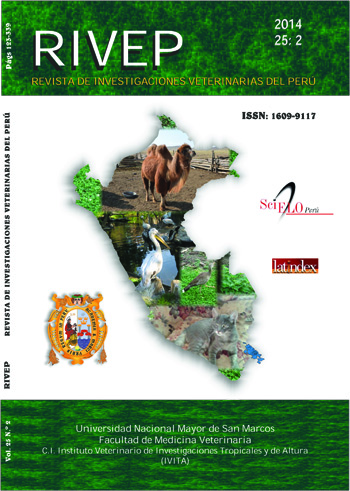ANATOMOPATHOLOGICAL DESCRIPTIONOF LESIONS OF GASTROINTESTINAL HELMINTHS IN MOTELO TORTOISES (Chelonoidis denticulata)
DOI:
https://doi.org/10.15381/rivep.v25i1.8466Keywords:
Chelonoidis denticulata, gastrointestinal tract, helminths, lesionsAbstract
The present aimed to identify and describe lesions caused by helminths in motelo tortoises(Chelonoidis denticulata). Forty gastrointestinal tracts were collected at Belen market inIquitos, Peru where this species is sold for meat consumption. The macroscopic analysisshowed that 42.5, 70.0, and 100% of the stomachs, small intestine and large intestinerespectively were parasitizedor affected by pathological –possibly due to parasites–changes like nodules, blackish coloration areas, ulcers, perforations, thickening,congestion and hemorrhagic areas. Parasites of 11 species were collected: Labidurisgulosa, Labiduris zschokkei, Labiduris irineuta, Atractis marquezi, Klossinemellatravassosi, Sauricola sauricola, Chapiniella variabilis, Angusticaecum holopterumand Ophidascaris arndti (Nematoda), and Halltrema avitellina and Helicotrema spirale(Trematoda). Histologically, an invasion of the four gastrointestinal layers by parasiticstructures compatible with H. avitellina (and its eggs), C. variabilis, S. sauricola and unundetermined species of atractideus was observed mostly surrounded by inflammatoryexudates formed by eosinophiles, giant cells, lymphocytes and connective tissue. Also,the presence of eosinophilic infiltrate in the mucosa was found as a response to thecontact with O. arndti and H. spirale. The results showed that all animals presentedparasitic lesions in the large intestine, most of them severe; whereas lesions in stomachand small intestine were mainly moderate and mild.Downloads
Downloads
Published
Issue
Section
License
Copyright (c) 2014 Rosa Julca R., Eva Casas A., Alfonso Chavera C., Lidia Sánchez P., Nofre Sánchez P., Luisa Batalla L.

This work is licensed under a Creative Commons Attribution-NonCommercial-ShareAlike 4.0 International License.
AUTHORS RETAIN THEIR RIGHTS:
a. Authors retain their trade mark rights and patent, and also on any process or procedure described in the article.
b. Authors retain their right to share, copy, distribute, perform and publicly communicate their article (eg, to place their article in an institutional repository or publish it in a book), with an acknowledgment of its initial publication in the Revista de Investigaciones Veterinarias del Perú (RIVEP).
c. Authors retain theirs right to make a subsequent publication of their work, to use the article or any part thereof (eg a compilation of his papers, lecture notes, thesis, or a book), always indicating the source of publication (the originator of the work, journal, volume, number and date).










